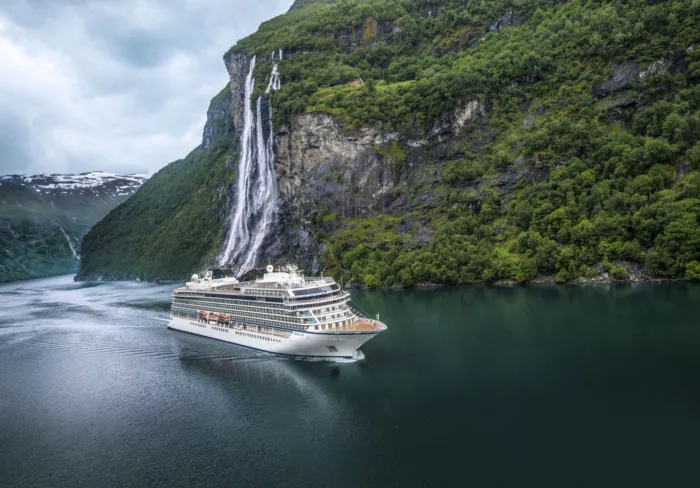
Viking Ocean Cruises
Viking began as a river cruise line and entered the ocean-cruise market with the launch of the 930-guest Viking Star.
Viking has already made an indelible mark on the sector with its fleet of stylish, near-identical, adult-only ships.
The cruise line currently has 10 ships in its fleet.
930
Passengers
465
Crew
2017
Launched
48000t
Tonnage
227m
Length
29m
Width
20kts
Speed
9
Decks
EUR
Currency
Cruise Itinerary
Day 1
Fort Lauderdale, Florida, United States
Day 2
,
Day 3
Cozumel, Mexico
Days 4 - 5
,
Day 6
Cartagena, Colombia
Day 7
Colón, Panama
Days 8 - 9
,
Day 10
Puntarenas, Costa Rica
Days 11 - 14
,
Day 15
Cabo San Lucas, Mexico
Days 16 - 17
,
Day 18
Los Angeles, California, United States
Days 19 - 23
,
Days 24 - 25
Honolulu, Hawaii, United States
Days 26 - 30
,
Day 31
Vaitape, French Polynesia
Day 32
Moorea, French Polynesia
Days 32 - 33
Papeete, Tahiti, French Polynesia
Day 34
,
Day 35
Rarotonga, Cook Islands
Day 36
,
Overnight
Day 37
At Sea
Relax and make the most of the myriad of facilities available on board the ship, from fantastic entertainment to delicious and diverse dining options.
Days 38 - 40
,
Day 41
Waitangi, Bay of Islands, New Zealand
Day 42
Auckland, New Zealand
Day 43
Tauranga, New Zealand
Day 44
Napier, New Zealand
Day 45
Wellington, New Zealand
Days 46 - 48
,
Days 49 - 50
Sydney, New South Wales, Australia
Day 51
,
Day 52
Mooloolaba, Queensland, Australia
Day 53
,
Day 54
Airlie Beach, Australia
Days 55 - 56
Cairns, Queensland, Australia
Days 57 - 59
,
Day 60
Darwin, Northern Territory, Australia
Days 61 - 62
,
Day 63
Rinca Island, Indonesia
Day 64
Lombok, Indonesia
Days 65 - 66
Benoa, Bali, Indonesia
Day 67
,
Day 68
Semarang, Indonesia
Days 69 - 70
Jakarta, Indonesia
Day 71
,
Days 72 - 73
Singapore, Singapore
Day 74
,
Day 75
Port Klang, Malaysia
Day 76
Langkawi Island, Malaysia
Day 77
Georgetown, Penang, Malaysia
Day 78
Phuket, Thailand
Days 79 - 80
,
Days 81 - 82
Colombo, Sri Lanka
Day 83
,
Day 84
Male, Maldives
Days 85 - 87
,
Day 88
Victoria, Mahé, Seychelles
Days 89 - 90
,
Days 91 - 92
Mombasa, Kenya
Days 93 - 94
Zanzibar, Tanzania
Day 95
,
Day 96
Hell-Ville, Madagascar
Days 97 - 99
,
Day 100
Maputo, Mozambique
Day 101
Richards Bay, South Africa
Day 102
Durban, South Africa
Day 103
East London, South Africa
Day 104
Gqeberha (ex Port Elizabeth), South Africa
Day 105
,
Days 106 - 107
Cape Town, South Africa
Day 108
,
Day 109
Lüderitz, Namibia
Days 110 - 111
Walvis Bay, Namibia
Days 112 - 113
,
Day 114
Luanda, Angola
Days 115 - 120
,
Day 121
Praia, Santiago Island, Cape Verde
Day 122
Mindelo, São Vicente Island, Cape Verde
Days 123 - 124
,
Day 125
Puerto de la Estaca, Santa Cruz de Tenerife, Canary Islands, Spain
Days 126 - 127
Agadir, Morocco
Days 128 - 129
Casablanca, Morocco
Day 130
Cádiz, Spain
Days 131 - 132
Lisbon, Portugal
Day 133
Leixões, Portugal
Day 134
La Coruña, Spain
Day 135
,
Day 136
Le Havre, France
Day 137
Dover, England
Days 138 - 139
London (Greenwich), England

Day 1
Fort Lauderdale, Florida, United States

Day 2
,

Day 3
Cozumel, Mexico

Days 4 - 5
,

Day 6
Cartagena, Colombia

Day 7
Colón, Panama

Days 8 - 9
,

Day 10
Puntarenas, Costa Rica

Days 11 - 14
,

Day 15
Cabo San Lucas, Mexico

Days 16 - 17
,

Day 18
Los Angeles, California, United States

Days 19 - 23
,

Days 24 - 25
Honolulu, Hawaii, United States

Days 26 - 30
,

Day 31
Vaitape, French Polynesia

Day 32
Moorea, French Polynesia

Days 32 - 33
Papeete, Tahiti, French Polynesia

Day 34
,

Day 35
Rarotonga, Cook Islands

Day 36
,

Day 37
At Sea

Days 38 - 40
,

Day 41
Waitangi, Bay of Islands, New Zealand

Day 42
Auckland, New Zealand

Day 43
Tauranga, New Zealand

Day 44
Napier, New Zealand

Day 45
Wellington, New Zealand

Days 46 - 48
,

Days 49 - 50
Sydney, New South Wales, Australia

Day 51
,

Day 52
Mooloolaba, Queensland, Australia

Day 53
,

Day 54
Airlie Beach, Australia

Days 55 - 56
Cairns, Queensland, Australia

Days 57 - 59
,

Day 60
Darwin, Northern Territory, Australia

Days 61 - 62
,

Day 63
Rinca Island, Indonesia

Day 64
Lombok, Indonesia

Days 65 - 66
Benoa, Bali, Indonesia

Day 67
,

Day 68
Semarang, Indonesia

Days 69 - 70
Jakarta, Indonesia

Day 71
,

Days 72 - 73
Singapore, Singapore

Day 74
,

Day 75
Port Klang, Malaysia

Day 76
Langkawi Island, Malaysia

Day 77
Georgetown, Penang, Malaysia

Day 78
Phuket, Thailand

Days 79 - 80
,

Days 81 - 82
Colombo, Sri Lanka

Day 83
,

Day 84
Male, Maldives

Days 85 - 87
,

Day 88
Victoria, Mahé, Seychelles

Days 89 - 90
,

Days 91 - 92
Mombasa, Kenya

Days 93 - 94
Zanzibar, Tanzania

Day 95
,

Day 96
Hell-Ville, Madagascar

Days 97 - 99
,

Day 100
Maputo, Mozambique

Day 101
Richards Bay, South Africa

Day 102
Durban, South Africa

Day 103
East London, South Africa

Day 104
Gqeberha (ex Port Elizabeth), South Africa

Day 105
,

Days 106 - 107
Cape Town, South Africa

Day 108
,

Day 109
Lüderitz, Namibia

Days 110 - 111
Walvis Bay, Namibia

Days 112 - 113
,

Day 114
Luanda, Angola

Days 115 - 120
,

Day 121
Praia, Santiago Island, Cape Verde

Day 122
Mindelo, São Vicente Island, Cape Verde

Days 123 - 124
,

Day 125
Puerto de la Estaca, Santa Cruz de Tenerife, Canary Islands, Spain

Days 126 - 127
Agadir, Morocco

Days 128 - 129
Casablanca, Morocco

Day 130
Cádiz, Spain

Days 131 - 132
Lisbon, Portugal

Day 133
Leixões, Portugal

Day 134
La Coruña, Spain

Day 135
,

Day 136
Le Havre, France

Day 137
Dover, England

Days 138 - 139
London (Greenwich), England
Ship Details


Viking Ocean Cruises
Viking Sky
With their sleek, yacht-style bows and teak promenade decks, Viking’s ocean ships are a million miles from the large liners that sail the seas.
Cabins
All Prices




















